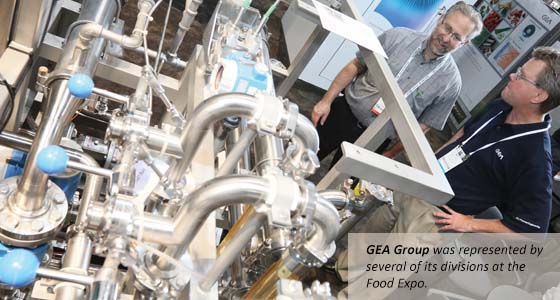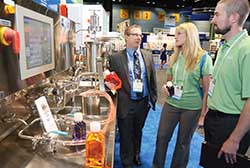Exhibiting Progressive Approaches to Processing
PROCESSING

A number of new ideas in processing and packaging caught my attention at the 2013 IFT Food Expo® in Chicago. Space allows for only a few highlights here.
Steam Sterilization of Solids
Steam sterilization of solids such as tea, herbs, and nuts continues to be a fast-moving and competitive area. At least five firms exhibited, including Log5 Corporation, Phoenix, Md. (www.log5.com); Natprocess, Lyon, France ([email protected]); Safesteril, represented in the United States by Norris Thermal Technologies, Tippecanoe, Ind. (www.safesteril.com); Imtech-Steri AG, Biel-Benken, Switzerland (www.imtech-steri.ch); and Imtech Ventilex, Middletown, Ohio (www.imtechventilex.com).
The processes have in common the idea of a brief exposure to steam to achieve a 5 log reduction in pathogens followed by rapid cooling and drying to avoid damage to the dry products by excess moisture. The Log5 process uses multiple batch chambers to achieve nearly continuous flow with cooling in a separate chamber. The Natprocess unit uses an enclosed vibratory conveyor heated by electrical resistance. The Safesteril process uses an electrically heated screw conveyor to heat and a second screw conveyor to cool with dehumidified air. The Imtech-steri system uses a batch chamber in which packaged product is treated. The Imtech Ventilex system uses a rotary valve to introduce dry solids to a continuous autoclave in which the material is transported by a vibrating conveyor through another rotary valve to a drying and cooling chamber, also vibrating. Ventilex is also known for its bread crumb drying systems.
As can be seen from these brief descriptions, the different manifestations of essentially the same process involve different means of material handling and, in some cases, of supplemental heat transfer.
Specialized PumpsThe Pump Solutions Group displayed several of its unique brands. Wilden, Grand Terrace, Calif. (http://www.psgdover.com/en/wilden/home), is well known for its diaphragm pumps, which can achieve high pressures and can be very sanitary since moving fluid contacts only the polymer diaphragm. Quattro Flow, Kamp-Lintfort, Germany (www.quattroflow.com), offers a variety of specialized small pumps including one-use pumps for medical or other uses in which potential cross-contamination is intolerable. In these devices, the pump head can be totally replaced while retaining the drive. One application suggested was metering distinctive flavors or colors.
Another Quattro Flow pump was developed to move blood and other fragile fluids by mimicking the action of the human heart, using four diaphragms driven by an eccentric shaft.
Finally, Mouvex, Auzerre, France (www.mouvex.com), claims that its eccentric disk pump can run dry and has no seals. The impact is that such a pump can completely empty both the feed and discharge lines, potentially saving large amounts of money from avoided waste.
Freeze Drying
GEA Group is a highly diversified supplier of food processing equipment. Its U.S. Process Engineering division is in Hudson, Wis. (www.geap.com). One of the firm’s more interesting products is the CONRAD Process for continuous freeze drying. In this process, frozen granules of a liquid, such as coffee extract, are distributed onto trays, which are automatically loaded through an airlock into a long cylindrical vacuum chamber. The trays are pushed in stacks between heated plates. Sublimed water vapor is condensed to ice on chilled heat exchangers. Periodically, the ice condensers are warmed to melt the ice and keep the system operating. According to GEA, up to 30,000 30 x 40 mm soup blocks can be dried per hour in one machine. Clearly the system is oriented toward large-scale production of a single product or several products that are so similar that the drying behaviors are the same.
Building and HVAC Innovations
Mundane as it may seem, specifying washable, non-corroding wall and ceiling finishes for food plants is a constant debate. Popular choices include epoxy paint over concrete masonry units (CMU) (concrete blocks in other words), fiberglass reinforced panels, and insulated sandwich panels, often called reefer panels because they are common in refrigerated or frozen spaces. Extrutech Plastics Inc., Manitowoc, Wis. (www.epiplastics.com), offers a new concept of polyvinyl chloride (PVC) panels with a tongue and groove seam system. The panels have a nailing fin that is covered by the seam, so fasteners are not exposed. The company also offers ceiling panels and doors with similar appearance and properties.
Controlling humidity in food plants can be a significant issue because many food facilities are refrigerated, such as meat processing plants and those producing ready-to-eat (RTE) foods, such as sandwiches. Cooling air increases the relative humidity to the point that condensation readily occurs and cooling coils can develop frost, requiring energy-wasting defrost cycles. An efficient solution is liquid desiccant dehumidification, in which fresh or recirculated air is exposed to a strong solution of a salt, such as lithium chloride. Imtech DryGenic, a large European firm, is represented in the United States by Imtech Ventilex USA Inc., Cincinnati, Ohio (www.imtechdrygenic.com), and supplies such systems.
--- PAGE BREAK ---
Another source for liquid desiccant systems is Advantix, Sunrise, Fla. (www.advantixsystems.com). In these systems, the desiccant is regenerated using heat. Imtech tries to use waste heat while Advantix uses electric heating. All such systems also purify air by removing suspended matter and killing microbes, so they make particular sense for applications such as curing rooms for dry sausage.
Edible Inks
Two firms offered edible inks and systems for using them to personalize foods or otherwise apply graphics directly to food surfaces. Markem-imaje, Keene, N.H., and Kennesaw, Ga. (www.markem-imaje.com), offers wax-based inks suitable for ink jet printing. Fujifilm Dimatix Inc., Santa Clara, Calif. (www.dimatix.com), offers a variety of ink jet printers that can deposit different functional fluids with features as small as 20 microns, as well as edible inks that are glycol- and dye-based.
Flexible Tubing
Saint-Gobain Performance Plastics, Akron Ohio (www.processsystems.saint-gobain.com), has reformulated its well-known line of Tygon flexible tubing to eliminate phthalate plasticizers, which are undesirable in food contact service. Flexible tubing can often substitute for stainless steel tubing in delivering compressed air for instrument control. Larger-diameter tubing is often used in fluid transfers and to connect flow plates.
Membranes for Dairy Ultrafiltration
Hydranautics, a Nitto Denko Company, Oceanside, Calif. (www.membranes.com), presented its DairyUF 5K series of polyethersulfone ultrafiltration membranes in a tightly wound cross-flow configuration, which the company says gives greater flow rates than other spiral wound membranes. Feed rates range from 30 gal to 80 gal per minute (GPM) at 15 psi pressure drop per module. Outside diameters range from 3.78 in to 7.90 in, and the modules are 35.5 in to 40 in long.
 Miniature Plant Equipment
Miniature Plant Equipment
MicroThermics, Raleigh, N.C. (www.microthermics.com), has offered small-scale heat exchange equipment suitable for small production trials for years. Their newest offering is an entry-level system that has fewer bells and whistles—simpler process controls, for instance—and so a lower cost than some of the firm’s other models. They also offer the service of performing runs on their equipment at their site in Raleigh. Typical applications are dairy-based beverages, soy milk, puddings, and juices.
Training
The Global Food Protection Institute, Battle Creek, Mich. (gfpi.org), is dedicated to protecting he world’s food supply by offering regulation and standards-based training, advancing new food protection technologies, and convening forums for the transformative exchange of ideas about food protection. I recently spoke at one of these forums and was impressed by the quality of the other speakers and the active engagement of attendees.
Debittering Citrus Juices
Dow Water and Process (http://www.dowwaterandprocess.com) showed an adsorbent resin for debittering citrus juices. All oranges contain limonic acid. As shown in Figure 1, over time, this acid naturally esterifies to limonin, a highly bitter compound with very low organoleptic detection limits.
For most commercial oranges, limonin resides in the membrane structures and is extracted when trying to enhance juice yield through such techniques as core, pulp, and peel washing. A similar bitter compound called naringin is found in grapefruit. By using a combination of ultrafiltration (UF) and polymeric adsorbents from Dow Water & Process solutions, citrus juice suppliers can debitter citrus juice to improve both product quality and the yield from raw materials.
The debittering process starts as pulp is separated from the juice using UF. Then the juice is contacted with an AMBERLITE™ FPX66 in a packed bed column and the pulp is returned to the juice prior to packaging or evaporation.
AMBERLITE FPX66 is the ideal adsorbent for this application, says Dow, because it has the perfect balance of properties. Its selectivity means it preferentially removes limonin while leaving other flavor components in the juice. It has high capacity—the high surface area results in high limonin capacity, and throughputs are not limited by adsorbent capacity. And its physical and oxidative stability allow the adsorbent to perform well for many years.This combination of properties results in a robust and economical process. At typical rates, the bed is on stream for 10 hr to 12 hr then is regenerated in 5 hr.
--- PAGE BREAK ---
Dry Ice CleaningCold Jet (www.coldjet.com) offers a simple alternative to sandblasting or using nut shells as abrasive cleaners by using dry ice, solid carbon dioxide, propelled by compressed air. The dry ice sublimates, leaving no residue. One can envision it helping to clean extrusion screws that often get fouled by cooked-on residues, or other surfaces that are difficult to clean.
Novel Intermediate Bulk and Shipping Containers
Buckhorn Inc., Milford, Ohio (www.buckhorninc.com), offers a wide line of reusable plastic containers, many of which are collapsible or stackable for efficient storage and shipping when empty. They particularly emphasized their 640 cheese container, which replaces wood boxes, avoiding the risk of splinter contamination, while being lighter than wood and taking less space when empty and collapsed. Buckhorn also showed a 60 gal rectangular, collapsible drum for liquids or solids, which offers better volume utilization in shipping and storage than comparable 55 gal cylindrical drums.
Another idea related to shipping came from Buffers USA, Jacksonville, Fla. (www.desiccant-solutions.com). The company offers a variety of special pouches intended to be placed in trucks or containers to control humidity in the atmosphere. The mechanism is calcium chloride, which attracts moisture and dissolves to form a liquid brine, which in turn is captured. Buffers contrasts this with solid absorbents, which can release moisture as temperature cycles during transportation.
The company also offers desiccant pouches intended to be used within packaging, as does Multisorb, Buffalo, N.Y. (www.multisorb.com), which also offers oxygen absorbers for active food packages.
Waste Treatment
ADI Systems Inc., Fredericton, New Brunswick, Canada (www.adisystemsinc.com), offers a variety of waste treatment technologies directed at high strength waste water such as is often produced by food plants. In particular, they presented the ADI-ECSB (External Circulation Sludge Bed), which is an anaerobic, ultra-high rate, high density system that can handle influent loading rates up to 30 kg/m3.d COD (chemical oxygen demand). That is a very high loading indeed.
Anaerobic digestion produces biogas, mostly methane, which can be an alternate energy source or can be used for co-generation. The footprint of the system is said to be small.
 J. Peter Clark, Ph.D., CFS,
J. Peter Clark, Ph.D., CFS,
is Contributing Editor to Food Technology magazine
and Consultant to the Process Industries, Oak Park, Ill.
([email protected]).
